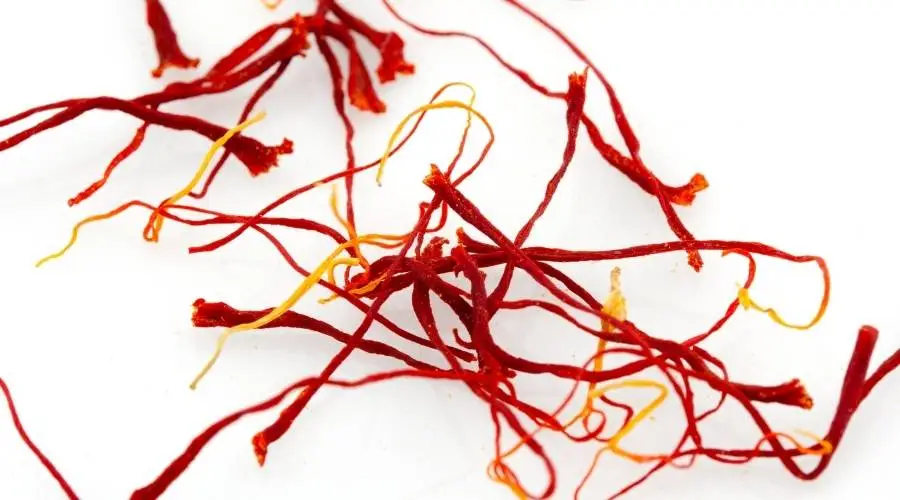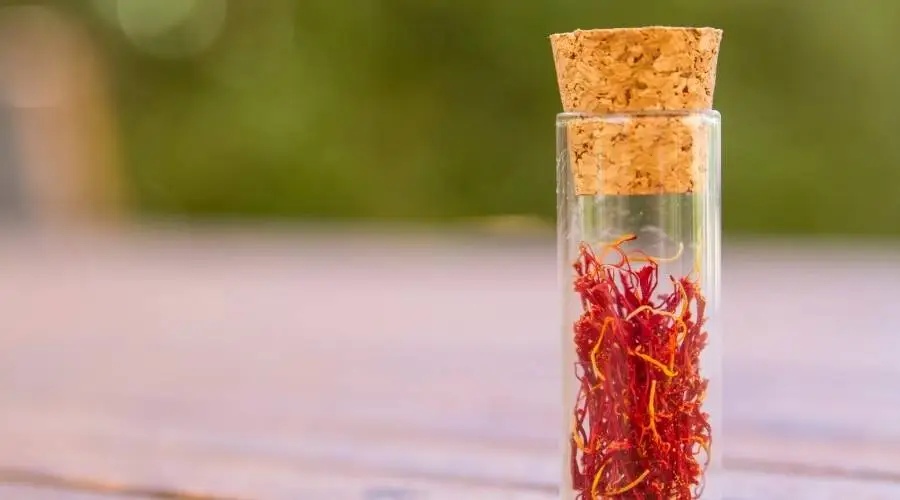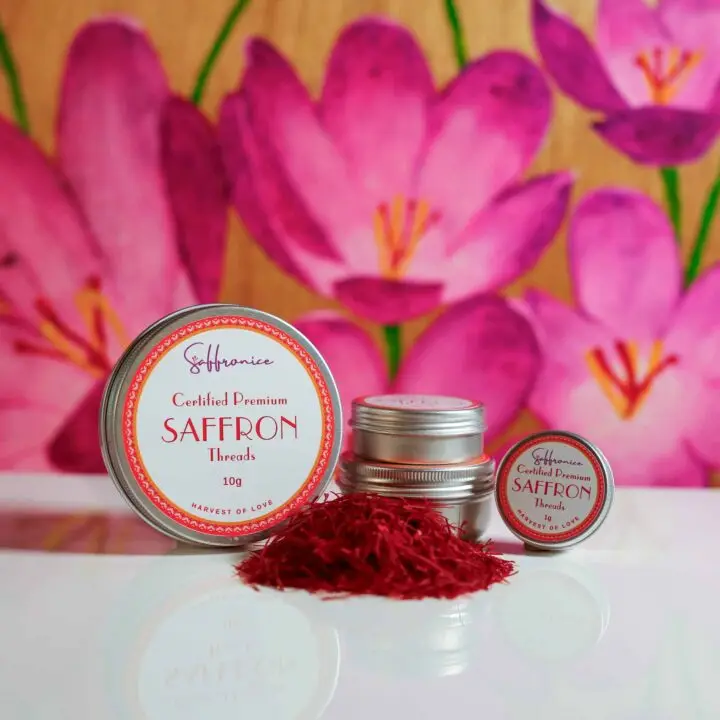📌 Quick Answer: Safe daily saffron dosage ranges from 15-30mg for therapeutic benefits, with clinical studies using 20-100mg for specific conditions. For depression: 30mg daily, sleep support: 50-100mg, general wellness: 15-20mg. Culinary use (5-10 threads) is always safe. Never exceed 1.5g daily to prevent toxicity. Always consult healthcare providers for personalized dosing.
Saffron, often referred to as the “red gold” of cooking, is a spice that stands out with its wonderful aroma, bright golden color, and complex taste. Understanding what saffron is reveals why it comes from the delicate stigmas of the Crocus sativus flower and is treasured in Mediterranean and Middle Eastern dishes. Beyond its culinary excellence, saffron is available as a supplement known for remarkable health benefits.
To fully experience saffron’s advantages for both mind and body, understanding proper dosage is crucial. Finding the perfect balance is key—excessive daily saffron may pose safety risks, while precise amounts can enhance well-being, therapeutic benefits, and sensory pleasure to their highest levels.
Medical Expert Insight: Proper saffron dosing requires understanding the significant difference between therapeutic supplementation and culinary use. Clinical evidence provides clear guidelines for safe, effective daily intake that maximizes benefits while minimizing risks.
This comprehensive guide explores evidence-based dosing protocols, safety considerations, and practical applications to help you optimize saffron’s therapeutic potential safely and effectively.

Understanding Saffron: Origins, Composition, and Therapeutic Foundation
Botanical Origins and Cultivation Process
Saffron cultivation involves an intricate process that affects both quality and therapeutic potency. Each Crocus sativus flower produces only three stigmas, requiring thousands of flowers for just one ounce of this precious spice.
Key Botanical Facts:
- Scientific name: Crocus sativus
- Primary growing regions: Iran (90% of world production), Spain, Kashmir, Greece
- Harvest timing: Early morning during the 6-week autumn flowering period
- Processing method: Hand-picking followed by careful drying to preserve bioactive compounds
This labor-intensive harvesting method contributes to saffron’s luxurious reputation and ensures the concentration of therapeutic compounds that make proper dosing so important.
Bioactive Compounds and Therapeutic Mechanisms
The distinct therapeutic effects of saffron come from three primary bioactive compounds:
Crocin (25-30% of extract):
- Provides vibrant golden color and potent antioxidant properties
- Crosses the blood-brain barrier for neurological benefits
- Responsible for mood enhancement and neuroprotective effects
- Determines therapeutic potency in standardized extracts
Safranal (1-3% of extract):
- Creates a characteristic honey-hay aroma
- Provides mood-enhancing and anxiolytic effects
- Influences neurotransmitter systems (serotonin, dopamine)
- Contributes to sleep quality improvements
Picrocrocin (5-15% of extract):
- Contributes to a distinctive bitter-sweet taste
- Offers anti-inflammatory and analgesic properties
- Supports digestive health benefits
- Enhances the bioavailability of other compounds
Kaempferol and other flavonoids:
- Provide additional antioxidant and anti-inflammatory support
- Support cardiovascular health benefits
- Enhance overall therapeutic synergy
Historical Context and Traditional Dosing
Saffron in ancient medicine provides valuable insight into traditional dosing practices that inform modern recommendations:
Traditional Persian Medicine:
- Therapeutic teas: 5-8 threads steeped in warm water
- Medicinal preparations: Equivalent to 10-20mg modern extract
- Pregnancy support: Extremely minimal amounts (1-2 threads occasionally)
- General wellness: Daily culinary use of rice and milk preparations
Ayurvedic Applications:
- Depression and mood: 15-25mg equivalent daily in milk preparations
- Digestive support: 5-10mg with meals
- Cognitive enhancement: 20-30mg in traditional formulations
- Sleep support: 10-15mg in evening preparations
Clinical Evidence and Therapeutic Dosing Protocols
Evidence-Based Dosage Ranges for Specific Conditions
Depression and Mood Enhancement: Saffron for depression research provides the most robust dosing evidence:
Clinical Trial Results:
- Standard dose: 30mg daily (divided into 15mg twice daily)
- Study duration: 6-8 weeks for initial benefits, 12+ weeks for full effects
- Success rate: 75-80% of participants showed significant improvement
- Comparison studies: Equivalent effectiveness to 20mg fluoxetine or 100mg imipramine
Sleep Quality and Insomnia: Saffron sleep benefits research demonstrates optimal dosing for rest:
Recommended Protocols:
- Mild sleep issues: 25-50mg taken 1-2 hours before bedtime
- Chronic insomnia: 75-100mg daily (under medical supervision)
- Sleep quality improvement: 50mg daily for 4-6 weeks
- Combined with milk: Traditional preparation enhances absorption
General Wellness and Antioxidant Support:
- Maintenance dose: 15-20mg daily with meals
- Antioxidant protection: 20-25mg daily for cellular health
- Cognitive support: 25-30mg daily for memory and focus
- Anti-inflammatory effects: 20-30mg daily for systemic inflammation
Age-Specific Dosing Considerations
Adults (18-65 years):
- Therapeutic range: 15-100mg daily, depending on condition
- Starting dose: 15mg daily, gradually increasing as needed
- Maximum safe dose: 100mg daily under medical supervision
- Optimal timing: With meals to prevent gastric irritation
Older Adults (65+ years):
- Conservative starting dose: 10-15mg daily
- Therapeutic range: 15-75mg daily with careful monitoring
- Special considerations: Potential drug interactions, slower metabolism
- Medical supervision: Essential due to higher sensitivity
Young Adults (18-25 years):
- Starting dose: 15-20mg daily
- Therapeutic range: 20-100mg depending on needs
- Considerations: Higher metabolism may require standard adult doses
- Safety focus: Establishing healthy usage patterns early
Culinary vs. Therapeutic Dosing: Understanding the Difference
Culinary Applications and Safety
Learning how to cook with saffron reveals the significant difference between flavor enhancement and therapeutic dosing:
Traditional Culinary Amounts:
- Paella (6-8 servings): 10-15 threads (approximately 0.1-0.2g)
- Biryani (4-6 servings): 8-12 threads (approximately 0.1g)
- Risotto (4 servings): 6-10 threads (approximately 0.05-0.1g)
- Persian rice dishes: 5-8 threads per serving
Bioactive Content in Culinary Use:
- Daily culinary consumption: Equivalent to 1-5mg therapeutic extract
- Safety profile: No adverse effects reported with normal cooking amounts
- Therapeutic contribution: Minimal but consistent antioxidant support
- Cultural significance: Traditional wellness support through daily use
Supplement Standardization and Potency
Understanding Extract Concentrations:
- Standardized extracts: Guaranteed crocin content (typically 2-4%)
- Raw saffron powder: Variable potency (0.5-2% crocin)
- Saffron threads: Natural form requiring proper extraction
- Oil extracts: Concentrated safranal content for specific applications
Dosage Conversion Guidelines:
- 1mg standardized extract ≈ 10-15 saffron threads
- 30mg clinical dose ≈ 300-450 threads (approximately 3-4.5g raw saffron)
- Therapeutic supplements: Pre-measured for consistent dosing
- Quality considerations: Third-party testing ensures accurate potency
Safety Protocols and Risk Management
Understanding Toxicity Thresholds
Safe Dosage Boundaries:
- Therapeutic range: 15-100mg daily (well-tolerated in studies)
- Caution zone: 100-500mg daily (requires medical supervision)
- Toxic threshold: Above 1.5g daily (risk of adverse effects)
- Lethal dose: 12-20g (severe toxicity requiring emergency treatment)
Early Warning Signs of Overconsumption:
- Mild symptoms: Nausea, headache, dizziness, fatigue
- Moderate symptoms: Vomiting, diarrhea, mood changes, sleep disturbances
- Severe symptoms: Jaundice, bleeding disorders, cardiovascular effects
- Emergency signs: Difficulty breathing, severe abdominal pain, unconsciousness
Special Population Considerations
Pregnancy and Breastfeeding:
- Culinary amounts: Generally safe in normal food preparation
- Therapeutic doses: Contraindicated due to uterine stimulant effects
- Risk factors: Potential miscarriage with doses above 5mg daily
- Medical consultation: Essential for any supplementation during pregnancy
Medical Conditions Requiring Caution:
- Bipolar disorder: Mood-altering effects may trigger manic episodes
- Bleeding disorders: May increase bleeding risk
- Cardiovascular disease: Blood pressure effects require monitoring
- Liver disease: Metabolism may be impaired, affecting safe dosing
Drug Interactions and Contraindications: Understanding saffron side effects includes potential medication interactions:
- Antidepressants: Potential serotonin syndrome with combined use
- Blood thinners: Enhanced anticoagulant effects
- Blood pressure medications: Additive hypotensive effects
- Sedatives: Increased drowsiness and CNS depression

Quality Assessment and Product Selection
Ensuring Therapeutic Quality
Understanding saffron quality standards is crucial for therapeutic dosing accuracy:
Quality Indicators for Supplements:
- Standardized extracts: Guaranteed bioactive compound percentages
- Third-party testing: Verification of potency and purity
- Certificate of analysis: Detailed compound breakdown and contaminant testing
- GMP certification: Good manufacturing practices ensure consistent quality
Selecting Reliable Sources: Where to buy quality saffron affects dosing accuracy:
- Reputable suppliers: Established track record with quality documentation
- Origin verification: Clear documentation of growing region and harvest date
- Storage conditions: Proper packaging protecting from light and moisture
- Price considerations: Extremely low prices may indicate adulteration
Authentication and Purity Testing
Common Adulteration Issues:
- Artificial coloring: Added dyes mimicking saffron’s golden color
- Plant material additions: Safflower, turmeric, or corn silk mixed in
- Weight enhancement: Addition of oils or glycerin increases weight
- Chemical treatments: Artificial enhancement of color or aroma
Testing Methods for Verification:
- Visual inspection: Authentic threads have a trumpet-like shape with darker tips
- Water test: Real saffron releases color slowly, maintains thread structure
- Aroma assessment: Distinctive honey-hay scent without harsh chemical odors
- Laboratory analysis: Professional testing for crocin, safranal, and picrocrocin content
Practical Implementation and Monitoring
Creating Effective Dosing Schedules
Daily Timing Optimization:
- Morning doses: For mood and energy support (take with breakfast)
- Evening doses: For sleep and relaxation (1-2 hours before bedtime)
- Divided doses: For therapeutic effects (split daily amount into 2-3 doses)
- With meals: Always take with food to prevent gastric irritation
Building Sustainable Routines:
- Start low: Begin with the minimum effective dose and gradually increase
- Consistency matters: Daily use provides better results than sporadic high doses
- Track responses: Monitor improvements and any adverse effects
- Professional guidance: Regular consultation with healthcare providers
Monitoring and Adjustment Protocols
Response Assessment:
- Week 1-2: Monitor for immediate tolerance and any adverse effects
- Week 3-4: Assess early therapeutic benefits and adjust dosing if needed
- Week 6-8: Evaluate full therapeutic response and optimize long-term dosing
- Ongoing: Regular reassessment of benefits, risks, and dosing needs
When to Adjust Dosing:
- Insufficient benefits: Gradual increase within safe ranges
- Side effects: Reduce dose or temporarily discontinue
- Life changes: Adjust for stress, illness, or medication changes
- Seasonal variations: Consider mood and energy fluctuations
Integration with Comprehensive Health Approaches
Combining with Other Therapies
Complementary Approaches:
- Nutrition: Balanced diet supporting saffron absorption and effectiveness
- Exercise: Regular activity enhances mood and overall health benefits
- Sleep hygiene: Proper rest supporting therapeutic effects
- Stress management: Meditation and relaxation techniques amplify benefits
Professional Coordination:
- Medical supervision: Regular monitoring of therapeutic progress
- Nutrition counseling: Optimizing diet for enhanced saffron benefits
- Mental health support: Coordinating with therapy for mood-related applications
- Functional medicine: Addressing root causes alongside saffron supplementation
Long-Term Sustainability and Safety
Extended Use Considerations
Long-Term Safety Profile:
- 26-week studies: Demonstrate safety of therapeutic doses over extended periods
- Tolerance development: No evidence of diminishing effects with continued use
- Dependency risk: No physical dependence reported in clinical studies
- Withdrawal effects: No significant discontinuation symptoms documented
Periodic Assessment Requirements:
- Quarterly reviews: Evaluation of continued necessity and effectiveness
- Annual health checks: Comprehensive assessment of overall health status
- Laboratory monitoring: Periodic testing if using higher therapeutic doses
- Dosage optimization: Adjusting based on life changes and health evolution
Cost-Effectiveness and Value Considerations
Economic Factors in Dosing:
- Quality vs. price: Higher quality products provide better therapeutic value
- Dosing efficiency: Proper dosing maximizes benefits while minimizing waste
- Supplement vs. culinary: Understanding cost implications of different approaches
- Long-term investment: Quality products provide sustained benefits
Conclusion: Optimizing Saffron’s Therapeutic Potential
Understanding proper saffron dosage is essential for safely accessing this remarkable spice’s therapeutic benefits. Clinical research provides clear guidelines for effective daily intake, ranging from 15mg for general wellness to 100mg for specific therapeutic applications under medical supervision.
Key Dosing Principles:
- Evidence-based approach: Follow clinical research guidelines for optimal results
- Individual assessment: Personalize dosing based on health status and goals
- Quality assurance: Use standardized, tested products for accurate dosing
- Medical supervision: Consult healthcare providers for therapeutic applications
- Safety first: Respect dosage limits and monitor for adverse effects
Therapeutic Applications Summary:
- Depression and mood: 30mg daily with 75-80% success rate
- Sleep quality: 50-100mg daily for significant improvement
- General wellness: 15-20mg daily for antioxidant and anti-inflammatory support
- Culinary enhancement: 5-10 threads daily for flavor and minimal therapeutic benefit
Long-Term Success Factors: Sustainable saffron use requires balancing therapeutic goals with safety considerations, quality product selection, and professional medical guidance. When used appropriately within established dosing guidelines, saffron can provide significant health benefits while maintaining an excellent safety profile.
The integration of proper saffron dosing into comprehensive health approaches offers a bridge between traditional wisdom and evidence-based medicine, providing natural support for mood, sleep, cognitive function, and overall well-being throughout various life stages.
FAQs (Frequently Asked Questions)
What is the safest daily saffron dosage for beginners?
Beginners should start with 15mg daily with meals, gradually increasing to 20-30mg if needed. This allows assessment of individual tolerance while providing therapeutic benefits. Clinical studies show this range is safe for most adults, with benefits typically appearing within 2-4 weeks of consistent use.
How does therapeutic saffron dosing differ from culinary use?
Culinary use involves 5-10 threads (approximately 1-5mg equivalent) for flavor, while therapeutic doses range from 15-100mg daily for health benefits. Cooking amounts are always safe but provide minimal therapeutic effects, whereas supplement doses require careful measurement and medical consideration for optimal safety and effectiveness.
Can I take saffron daily long-term without side effects?
Yes, studies show daily doses up to 100mg are well-tolerated for 26+ weeks without significant side effects. However, long-term use should include periodic medical assessment, especially for doses above 30mg daily. Quality products from reputable sources are essential for safe long-term supplementation.
What’s the maximum safe saffron dose, and what happens if I exceed it?
The maximum safe therapeutic dose is 100mg daily under medical supervision, with 1.5g being the absolute upper safety limit. Exceeding safe doses can cause nausea, vomiting, dizziness, and potentially dangerous effects. Doses above 5g are considered toxic and require immediate medical attention.
How should I time my saffron doses for maximum effectiveness?
For mood benefits, take 15mg twice daily with meals. For sleep support, take 50-100mg 1-2 hours before bedtime. For general wellness, take 15-20mg with breakfast. Always take with food to prevent stomach upset and enhance absorption of bioactive compounds.
Do I need medical supervision for therapeutic saffron dosing?
Medical consultation is recommended for therapeutic doses above 30mg daily, for anyone with medical conditions, those taking medications, pregnant/breastfeeding women, and individuals with mental health conditions. Healthcare providers can personalize dosing and monitor for interactions or adverse effects.



